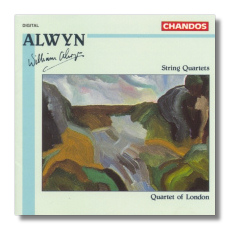
The Internet's Premier Classical Music Source
Related Links
- Alwyn Reviews
- Latest Reviews
- More Reviews
-
By Composer
-
Collections
DVD & Blu-ray
Books
Concert Reviews
Articles/Interviews
Software
Audio
Search Amazon
Recommended Links
Site News
 CD Review
CD Review
William Alwyn

- String Quartet #1 in D minor
- String Quartet #2 "Spring Waters"
Quartet of London
Chandos CHAN9219
For me, despite the considerable achievement of the symphonies, Alwyn at his most interesting can be found in the chamber music. Surely, the first movement of the String Quartet #1 is one of his most concentrated, with no more than three melodic cells, by my count. Alwyn puts them through some very sophisticated manipulations to come up with a richly expressive movement, suavely played by the Quartet of London, who match the composer subtlety for subtlety. The scherzo seems to me a "night" piece, something like Debussy's "Feux d'artifice," with little figures bursting against a textural "base." The emotional heart of the quartet beats in the slow movement, a quiet beauty with scarcely any climax at all, yet unbelievably intense. The finale seems to recall ideas from previous movements, but not in the obviously cyclical way. Alwyn transmogrifies the ideas into new shapes which lead to new paths, all the while coming up with a prodigal supply of inventive and lovely textures for the string quartet.
Twenty years later, in 1975, Alwyn came up with his second string quartet. In the meantime, he had experimented in a (not surprisingly) individual way with Schoenbergian serialism, although he never gave up the drama inherent in the clash of large tonal centers. This exploration had the effect of tightening his music even more. As closely-argued as the first quartet is, in the second, Alwyn grows the entire composition from the first movement's opening bars.
Alwyn saw the work as an expression of regret and wrath of old age against death - a kind of "Do not go gentle." Surely, a great deal of sadness and rage run through the piece, but much of the rage gets transmuted to resignation, as in the first movement when the rhythm of angry, pesante chords become a lament. The second movement, a scherzo, begins with the first movement's opening melodic idea harmonized in clusters. The melodic shapes of the first movement are retained, but Alwyn distorts them rhythmically. For him, this is the "turbulence" of youth and young love "'seen through a glass darkly." Obviously, Alwyn takes his considerable craft almost for granted. For him, music really should express emotional states - what Arnold Bax would define as musical Romanticism.
The last movement begins as bleakly as any in music. The "angry" chords of the first movement sound somewhat queasy with a sul ponticello effect in the strings (a bit like nails drawn slowly over a blackboard). The opening melodic idea becomes a slow fugue, with occasional eruptions of anger, quickly subsiding. The movement appears to end like the snuffing of a small candle, but the strings seem to rise, bloody but unbowed, for an heroic close.
The Quartet of London does well with a score that offers extreme challenges to interpretation, but this is obviously a work that needs to enter the repertory before we begin to get anything like its true measure. The chances of that happening, of course, hover around nil.
Despite the quality of the music and the performances, I wish to complain briefly about Chandos. They have put out a CD with a mere 44 minutes worth of music on it. I realize that obvious choices, like the String Quartet #3, have come out on other Chandos CDs, but I can't really believe that Alwyn wrote nothing else to fill up the time. Despite this, I recommend the disc.
Copyright © 1996, Steve Schwartz


















